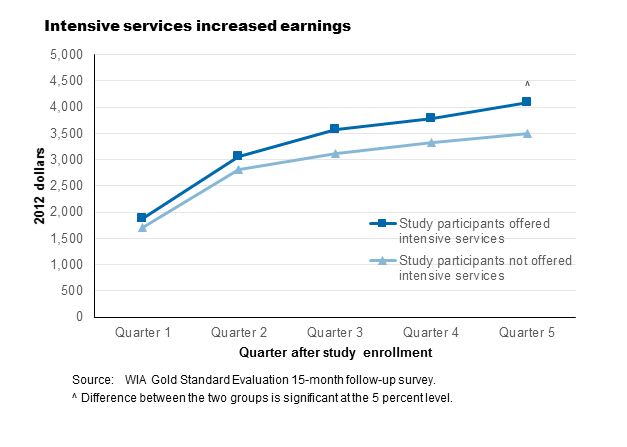According to interim findings from a rigorous national evaluation of services provided at American Job Centers through the Adult and Dislocated Worker programs, “intensive” services—staff assistance with finding and keeping a job—not only help people find a job but also lead to higher earnings.
First authorized by the Workforce Investment Act (WIA) in 1998 and reauthorized in 2014 by the Workforce Innovation and Opportunity Act (WIOA), the Adult and Dislocated Worker programs are two of the nation’s largest publicly funded employment and training programs. To rigorously assess the impact of these programs on job seekers’ employment and earnings, the Employment and Training Administration of the U.S. Department of Labor contracted with Mathematica Policy Research and our partners at Social Policy Research Associates, MDRC, and the Corporation for a Skilled Workforce to conduct a national evaluation.
In the 28 randomly selected local workforce investment areas across the country, evaluators assessed the effectiveness of two service types offered by the Adult and Dislocated Worker programs: (1) training and (2) intensive services. Because the local areas were selected randomly, the study findings pertain to job seekers in all local areas across the country.
Interim study findings include:
- Intensive services increased quarterly earnings by about $600, a jump of 17 percent, in the fifth quarter after job seekers were enrolled in the study. Intensive services also led to study participants obtaining jobs with more fringe benefits such as health insurance and retirement benefits.
- As expected, training reduced employment and earnings in the first few quarters after enrollment, as job seekers who were involved in training were less likely to have time for employment. By the fifth quarter, 13 to 15 months after enrolling in the study, these job seekers had yet to see their training result in higher employment rates or earnings. However, about 15 percent of all job seekers in the study were still in training in the fifth quarter after they enrolled. It may therefore be too early to see the benefits of training.
- Together, intensive services and training increased the likelihood of job seekers finding work, but this did not translate into an increase in earnings within the 15 months after enrollment.
“During our visits to American Job Centers across the country, I met with dedicated staff who wanted to help people refine their skills and find jobs. I’m pleased that our study has been able to quantify the impact of their important work,” said Mathematica Vice President Sheena McConnell, the co-project director.
Today’s release features new products from the evaluation, including a report and 11 special topic briefs from the process study and a report on the 15-month impacts. Next year, the U.S. Department of Labor and Mathematica will release findings from a review of study participants’ outcomes 30 months after enrollment. To read the reports and papers or to learn more about this study, please visit the project webpage.

